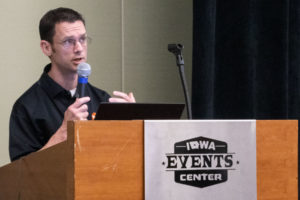
When selecting a sire to breed cows to, producers have an abundance of data at their disposal. Dr. Matt Spangler, University of Nebraska- Lincoln beef cattle geneticist, suggests accuracy values may not be as valuable as producers might think during his discussion at the Beef Improvement Federation (BIF) Symposium June 23 in Des Moines, Iowa.
To utilize accuracy values, producers must first understand what accuracy is and how accuracy is changes overtime. As the volume of recorded data on an individual’s offspring goes up, so does the accuracy associated with the individual’s EPD. It takes time to accumulate enough information for an animal to have high accuracy. Genomic testing is another method to collect data to increase accuracy values and is faster than waiting for progeny data, “breaking the antagonism between accuracy and generation interval,” Spangler explains.
It’s important to keep in mind, accuracy does not provide the producer information about variability of an animal’s offspring.
Spangler highlights faster genetic progress as a benefit increasing accuracy, but also notes the risks of a time delay in using progeny data alone to accrue accuracy. There is a difference in average genetic values between younger and older bulls, due to genetic trends, and sometimes younger bulls are genetically superior compared to their older counterparts. Consequently, selecting bulls based on accuracy alone could lead to selecting less desirable bulls.
Confidence intervals, on the other hand, are based on possible change, calculated as the standard error of prediction. This possible change represents how much an animal’s expected progeny difference (EPD) could change as the amount of information related to that EPD increases.
One way to think about possible change is that 68% of the time, an EPD will not move more than plus or minus one possible change value, Spangler explains. To be 95% confident, account for the EPD plus or minus roughly two possible change values.
“These possible change intervals… are a much easier way to conceptualize accuracy. If I want to be 68 or 95 percent confident that an animal’s EPD is within an acceptable range for me, this is the way to think about it,” Spangler says.
When it comes to commercial producers, Spangler says the value of accuracy is a personal decision. Is there a risk a producer is not willing to take with their herd? For example, if dystocia historically has not been an issue in a herd, that producer may not care as much about the accuracy of a potential sire’s calving ease EPDs. Valuing accuracy in this situation is a personal decision.
The bottom line: Spangler warns producers against selecting animals based solely on accuracy values and prefers the use of confidence intervals to accuracy.
To watch Spangler’s full presentation, visit https://youtu.be/dLh0fdMwag0. For more information about this year’s Symposium and the Beef Improvement Federation, including additional presentations and award winners, visit BIFSymposium.com.
